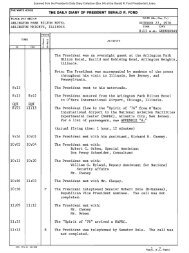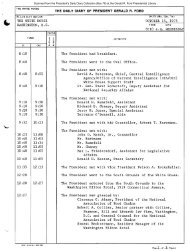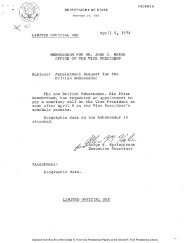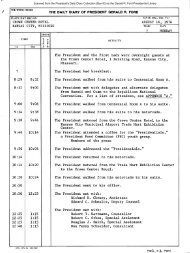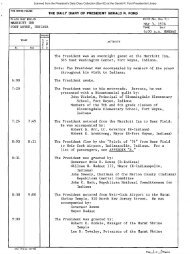October 31, 1975 - Gerald R. Ford Presidential Library and Museum
October 31, 1975 - Gerald R. Ford Presidential Library and Museum
October 31, 1975 - Gerald R. Ford Presidential Library and Museum
You also want an ePaper? Increase the reach of your titles
YUMPU automatically turns print PDFs into web optimized ePapers that Google loves.
The Tom O'Connor oil field is located in Refugio County, Texas, within<br />
the Oligocene belt of the Texas Gulf Coast.<br />
The principal producing zones are the 5,500; 5,800; <strong>and</strong> 5,900 foot<br />
Upper <strong>and</strong> Middle Frio s<strong>and</strong>stonesof Oligocene age.<br />
The structure at Tom O'Connor is an elon9ated anticline with almost<br />
15,000 productive acres (23 square miles).<br />
The oil recovery mechanism is an active water drive. There were<br />
small original gas caps in the 5,500 <strong>and</strong> 5,800 foot reservoirs.<br />
Hydrocarbons originally in place were estimated using the volumetric<br />
method. The study team utilized volumetric information which was<br />
furnished by the operators <strong>and</strong> also that from the Texas Railroad<br />
Commission files. Based upon their own examination, the study team<br />
reduced estimates of net pay thickness <strong>and</strong> increased estimates of<br />
connate water saturation from the amounts which. previously had been<br />
generally reported. This is most important in the case of the 5,900<br />
foot zone. A material balance analysis of hydrocarbons originally in<br />
place was not considered diagnostic because of poor water production<br />
records <strong>and</strong> complications caused by migration of fluids between zones.<br />
Oil production rates have apparently peaked in the 5,500 <strong>and</strong> 5,800<br />
foot zones, but the period of production decline has not been long<br />
enough to establish a predictable trend. The estimate of future<br />
reserves in these zones depends, of course, on the average future<br />
decline rate which has been estimated at about 15 percent per year.<br />
Over half of the reserves at Tom O'Connor are allocated to 5,900 foot<br />
s<strong>and</strong> which has current capacity to produce in excess of its MER of<br />
30,000 barrels daily. The reserves estimate for this zone .is based<br />
upon an oil recovery efficiency of about 67 percent, which was<br />
determined by empirical correlation methods.<br />
The FEA report on the Tom O'Connor Field was prepared by the Region<br />
VI Office of the Federal Energy Administration located in Dallas, Texas.<br />
162<br />
(





